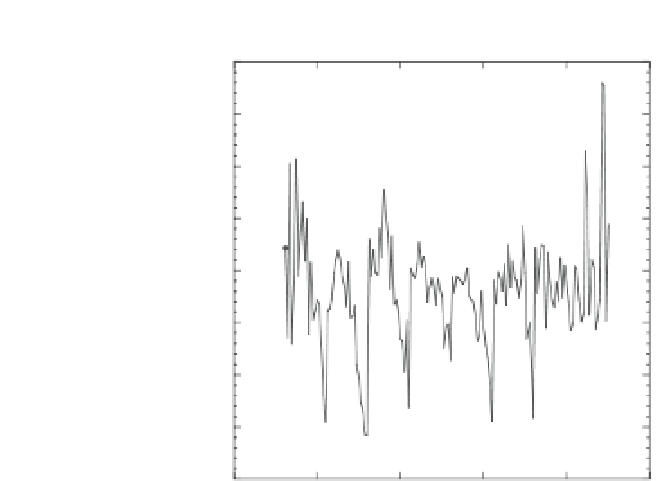Geology Reference
In-Depth Information
Magnetic parameter ratios
There are many different ratios of magnetic parame-
ters used to detect environmental processes. We can
only provide some of the most commonly used param-
eters and ratios here. The reader is directed to the envi-
ronmental magnetism or paleomagnetism topics cited
above for more examples. Usually, the ratios or param-
eters employed will depend on the environmental
process that is being investigated. For example, the
goethite to goethite + hematite ratio has been sug-
gested as a measure of the integrated climate, i.e. pre-
cipitation levels, in a sediment's source area (Harris &
Mix 2002). Hematite and goethite in a sample can be
detected by a series of magnetic measurements. Appli-
cation of a very high fi eld IRM, for instance 5 T applied
in an impulse magnetizer, will activate all the magnet-
ite, hematite and goethite in a sample. Alternating
fi eld demagnetization of the sample at 100 mT would
then remove the magnetic contribution of most (if not
all) of the magnetite in a sample, leaving only the hem-
atite and goethite. Finally, either thermal demagnetiza-
tion at a very low temperature (
c.
130 ° C) would remove
the goethite, leaving only the hematite, or a backfi eld
of about 1 T would show the relative abundance of
hematite to goethite as in the
S
- ratio for magnetite and
hematite mentioned above. An alternating fi eld demag-
netization of 100 mT would then be needed again to
remove the contribution of the magnetite reactivated
by the 1 T backfi eld.
These measurements are easy enough to make for
a large suite of samples, so the variation of this
environmental process can be observed through time
in a sedimentary section. The Neoprotereozoic Rain-
storm Member of the Johnnie Formation displays a
beautiful 5 m wavelength cycle of the magnetically
determined goethite to hematite ratio interpreted by
Kodama & Hillhouse (2011) to be about 100 kyr in
duration, thus giving a high-resolution estimate of
the duration of the Rainstorm member's deposition
(Fig. 8.1 ).
Fig. 8.1
Magnetically determined goethite to hematite
ratio for the Rainstorm Member of the Johnnie Formation
from Death Valley, CA showing a beautiful 5 m cycle.
Kodama & Hillhouse (2011) interpret this cycle to be
125,000 years in duration (short eccentricity). (See Colour
Plate 13)
basic rock magnetic principles and the ability to apply
them creatively to different environmental conditions.
Lake sediment environmental magnetism
Many environmental magnetic studies are conducted
on lake sediments because they provide excellent,
nearly continuous records of environmental processes
on the continents. They are an important complement
to environmental magnetic studies of marine sedi-
ments since environmental processes on land can be
compared and understood in the context of changes in
the global ocean. Li
et al
. (2006, 2007) studied the
environmental magnetism of Holocene-age sediments
from White Lake in northern New Jersey and were able
to detect changes in lake level through time. The
changes in lake level are, of course, a record of long-
term precipitation/evapo-transpiration changes in the
area. The magnetic properties of two cores collected
from the lake showed periodic high magnetic intensity
layers separated by
c.
1500 years of sediment deposi-
tion, based on a
DETECTING ENVIRONMENTAL
PROCESSES
Some examples of how different environmental
processes can be detected and studied using environ-
mental magnetic measurements now follow. All envi-
ronmental magnetic studies rely on the knowledge of
14
C age model for the lake sediment
























































































Search WWH ::

Custom Search